Stanford physicist Ingmar Riedel-Kruse has begun developing 'biotic games' involving paramecia and other living organisms. He hopes the games lead to advances in education and crowd-sourcing of laboratory research while helping to raise the level of public discourse on bio-related issues.
Jan 14th, 2011
Read more
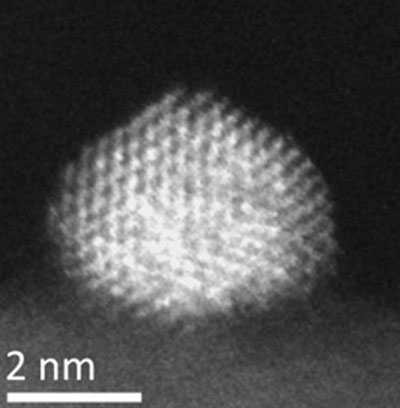 Nanoparticles of gold and palladium (Au-Pd) could lead to a more efficient and environmentally friendly way of producing benzyl benzoate, a chemical compound used widely in the food, pharmaceutical and chemical industries whose applications include a fixative for fragrances, a food additive and a solvent for chemical reactions.
Nanoparticles of gold and palladium (Au-Pd) could lead to a more efficient and environmentally friendly way of producing benzyl benzoate, a chemical compound used widely in the food, pharmaceutical and chemical industries whose applications include a fixative for fragrances, a food additive and a solvent for chemical reactions.
Jan 14th, 2011
Read more
The European Food Safety Authority has launched a public consultation on its draft guidance document for engineered nanomaterial (ENM) applications in food and feed.
Jan 14th, 2011
Read more
Magnetotactic bacteria orient themselves in their environment with the aid of tiny compasses, consisting of chains of membrane sacs called magnetosomes, each containing a single nanomagnet.
Jan 14th, 2011
Read more
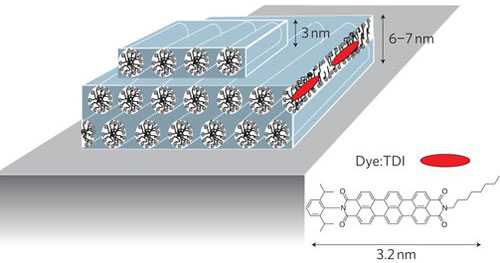 Wissenschaftler des Exzellenzclusters 'Nanosystems Initiative Munich' an derLMU haben eine Methode entwickelt, mit der sie Silikat-Nanoroehrchen trotz ihrer geringen Groesse direkt beim Wachsen zusehen koennen.
Wissenschaftler des Exzellenzclusters 'Nanosystems Initiative Munich' an derLMU haben eine Methode entwickelt, mit der sie Silikat-Nanoroehrchen trotz ihrer geringen Groesse direkt beim Wachsen zusehen koennen.
Jan 14th, 2011
Read more
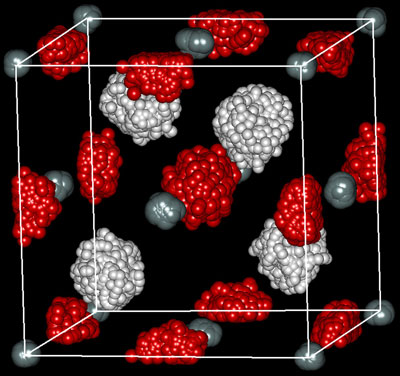 Most of our Universe consists of hydrogen atoms, which are often found under extraordinarily high pressure as high as tens of millions of times the atmospheric pressure of Earth. Understanding the exotic physics of such a high-pressure regime will contribute to our understanding of planet formation, hydrogen storage, room temperature superconductivity and other fields, explains Toshiaki Iitaka from the RIKEN Advanced Science Institute in Wako.
Most of our Universe consists of hydrogen atoms, which are often found under extraordinarily high pressure as high as tens of millions of times the atmospheric pressure of Earth. Understanding the exotic physics of such a high-pressure regime will contribute to our understanding of planet formation, hydrogen storage, room temperature superconductivity and other fields, explains Toshiaki Iitaka from the RIKEN Advanced Science Institute in Wako.
Jan 14th, 2011
Read more
Imaging system could help reveal 'miscommunications' in autism, schizophrenia.
Jan 14th, 2011
Read more
Nanopartikel spielen eine wesentliche Rolle bei der Entwicklung zukuenftiger diagnostischer und therapeutischer Methoden fuer Tumorerkrankungen, beispielsweise als Transporter fuer Wirkstoffe oder als Kontrastmittel. Aufnahme und Verteilung von Nanopartikeln im Tumorgewebe haengen dabei stark von der Partikelgroesse ab. Um dies systematisch untersuchen zu koennen, haben Wissenschaftler jetzt einen Satz fluoreszierender Nanopartikel verschiedener Durchmesser zwischen 10 und 150 nm hergestellt.
Jan 14th, 2011
Read more
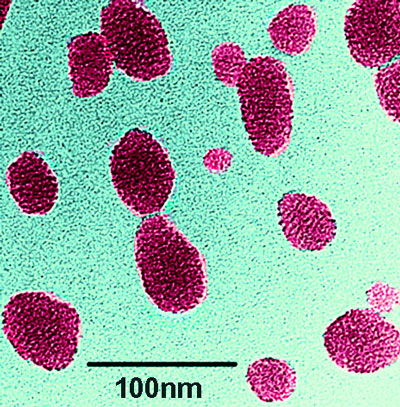 Clarkson University Physics Professor Igor Sokolov and his team have discovered a method of making the brightest ever synthesized fluorescent silica nanoparticles.
Clarkson University Physics Professor Igor Sokolov and his team have discovered a method of making the brightest ever synthesized fluorescent silica nanoparticles.
Jan 14th, 2011
Read more
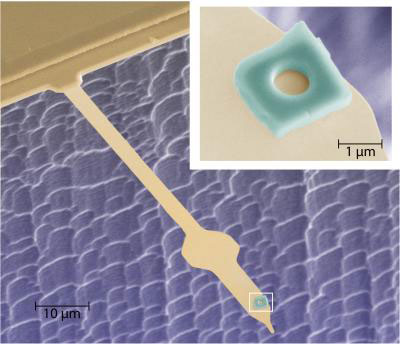 A new fractional vortex state observed in an unconventional superconductor may offer the first glimpse of an exotic state of matter predicted theoretically for more than 30 years. University of Illinois physicists, led by Raffi Budakian, describe their observations of a new fractional vortex state in strontium ruthenium oxide (SRO).
A new fractional vortex state observed in an unconventional superconductor may offer the first glimpse of an exotic state of matter predicted theoretically for more than 30 years. University of Illinois physicists, led by Raffi Budakian, describe their observations of a new fractional vortex state in strontium ruthenium oxide (SRO).
Jan 13th, 2011
Read more
Researchers at the University of Illinois and Northwestern University have demonstrated bio-inspired structures that self-assemble from simple building blocks: spheres. The helical 'supermolecules' are made of tiny colloid balls instead of atoms or molecules. Similar methods could be used to make new materials with the functionality of complex colloidal molecules.
Jan 13th, 2011
Read more
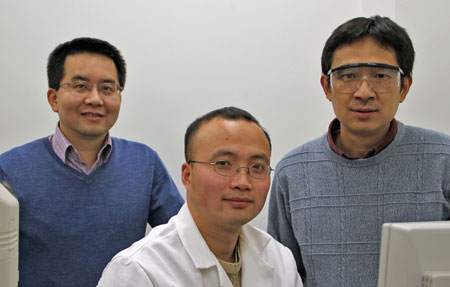 Advancements in understanding rotational motion in living cells may help researchers shed light on the causes of deadly diseases, such as Alzheimer's, according to Ning Fang, an associate scientist at the U.S. Department of Energy's Ames Laboratory and faculty member at Iowa State University.
Advancements in understanding rotational motion in living cells may help researchers shed light on the causes of deadly diseases, such as Alzheimer's, according to Ning Fang, an associate scientist at the U.S. Department of Energy's Ames Laboratory and faculty member at Iowa State University.
Jan 13th, 2011
Read more
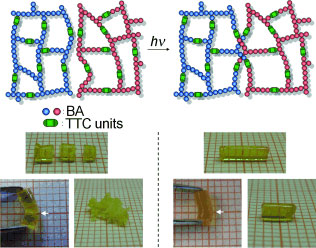 Materials with self-healing properties could help extend the durability of products and make repairs easier. Krzysztof Matyjaszewski and his co-workers at Carnegie Mellon University (Pittsburgh, USA) and Kyushu University (Japan) have now developed a polymer that can repair itself when irradiated with UV light - over and over again.
Materials with self-healing properties could help extend the durability of products and make repairs easier. Krzysztof Matyjaszewski and his co-workers at Carnegie Mellon University (Pittsburgh, USA) and Kyushu University (Japan) have now developed a polymer that can repair itself when irradiated with UV light - over and over again.
Jan 13th, 2011
Read more
A team of Northern Illinois University scientists, with a major role played by NIU Ph.D. students, has discovered a new, convenient and inexpensive way to make high performance hydrogen sensors using palladium nanowires.
Jan 13th, 2011
Read more
 Tissue engineers seek to develop functioning substitutes for damaged tissues and organs. Generally, this means seeding cells onto 3-dimensional porous scaffolds made of biomaterials, which provide mechanical support and instructive cues for the developing engineered tissue. Now it's time to go to the next level, and make complex tissues that can really do things - contract, release growth factors, conduct electrical signals and more. Things our own cells and tissues do.
Tissue engineers seek to develop functioning substitutes for damaged tissues and organs. Generally, this means seeding cells onto 3-dimensional porous scaffolds made of biomaterials, which provide mechanical support and instructive cues for the developing engineered tissue. Now it's time to go to the next level, and make complex tissues that can really do things - contract, release growth factors, conduct electrical signals and more. Things our own cells and tissues do.
Jan 13th, 2011
Read more
Acht Bundesministerien buendeln unter Federfuehrung des Bundesforschungsministeriums in der 'Nano-Initiative Aktionsplan 2015' ihre Forschungsfoerderung.
Jan 13th, 2011
Read more









 Subscribe to our Nanotechnology News feed
Subscribe to our Nanotechnology News feed